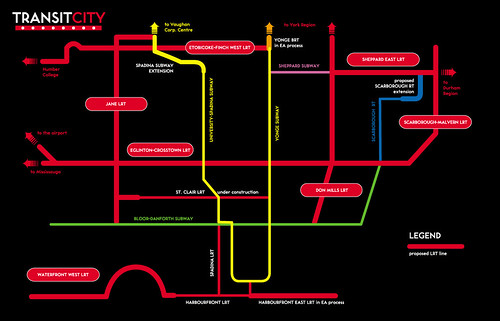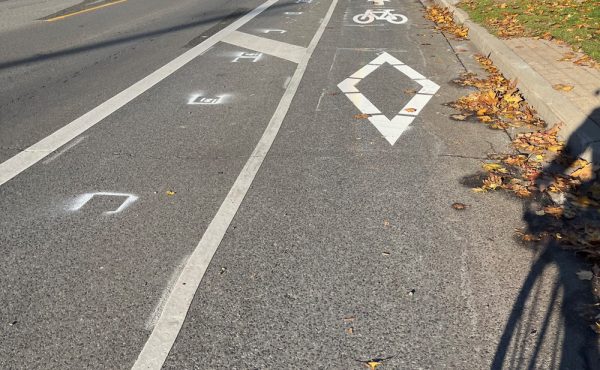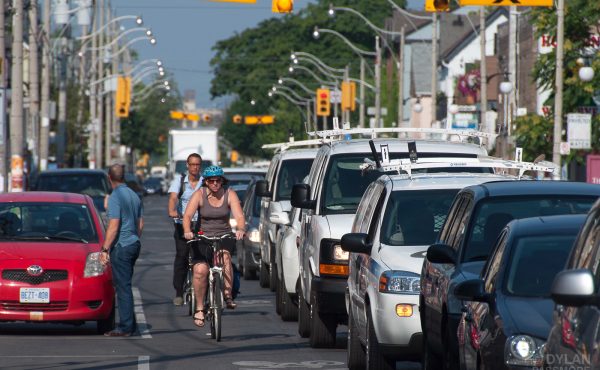Jessica Hume will be covering the Ourtopias at the Design Exchange June 15 to 16 for the Spacing Wire. “Ourtopias: Ideal cities and the roles of design in remaking urban spaces” runs June 14 to 16 at the Design Exchange. www.dx.org
– – – – – – – – – – – – – – – –
TTC Chair Adam Giambrone is excited today, and everyone in the room can feel it. Standing at the podium of the Design Exchange, the Toronto city councillor smiles broadly as he tells the audience that the province has just announced it will be giving $24 billion for public transit. The money will be split three ways among GO Transit, the 905 area and the city of Toronto.
“This money is enough to pay for the whole Transit City Plan, plus more,†Giambrone said. If it all goes through, Toronto “will be in a position to compete with Madrid,†a city known for its remarkable transit system.
Giambrone’s presentation, part of the OURTOPIAS design conference, is a discussion of the Transit City plan, the future of transit in Toronto. He says Toronto is a transit city, it’s just that the transit we have isn’t good enough.
“Transit pervades all aspects of urban culture,†he said. “Even if you don’t use transit, it’s still a very important part of city life.â€
Indeed. Streetcars, for one, have been a symbol of Toronto since the city’s early days. Giambrone sees the Transit City plan as an opportunity to redefine the city’s image. “Transit is about more than just getting people from A to B,†he said. “It’s also got to be about quality of service and enjoyment of public space.â€
While Torontonians are understandably loath to get too excited about anything promised by city council until it actually materializes, the plan looks good on paper. Giambrone is determined to think outside the public transit box, bringing architecture, sustainability, art and enjoyment of public space into the goals of improved public transit.
“We want to be the greenest transit authority in North America,†he said. “It’s not just about being fancy and modern, but also about transformation, reflecting the city’s commitment to sustainability.â€
Sustainability, as Giambrone sees it, isn’t just about getting people out of their cars. This year the TTC broke its own record for ridership. Transit in Toronto is seeing an increase of about 4% ridership a year. Not only does the TTC have to improve and expand to accommodate those choosing to ride the Rocket, but the ways it uses energy will have to become more efficient. Solar power and methane are possibilities for optimizing the TTC’s fleet of vehicles.
The Transit City plan involves the creation of seven new Light Rapid Transit (LRT) lines. The benefit of LRT is the fact the trains would have their own designated lanes, and therefore wouldn’t be competing in traffic with cars. The new routes would also provide more intraregional transportation, arguably the most important aspect of improved public transit. Most traffic congestion is a result of 905-416 commuters, not people travelling within the city boundaries.
“If you want people to get out of their cars,” the TTC chair chimes, “you need to give them some impetus for taking transit.â€
For a listing of the proposed routes, see the Spacing Wire post on Transit City.





15 comments
Transit City is no doubt a move in the right direction. However, it’d be nice to see some work done on improving east-west service downtown. If we can bury the central section of the Eglinton LRT, why not the downtown portion of the Queen streetcar?
Adam
the thinking is that all new lines should be right of way whereas Queen is already built. Eglinton between Keele and Laird is too narrow to be on street.
Disconnecting Queen and burying it would have implications for the ability of other downtown lines to cope with blockages – it would also have noise implications for the new Opera House which also has the subway. Might not be impossible but it won’t be simple, that’s for sure.
How far east does the proposed Harbourfront East line go?
bgm – this might be of help: http://www.stevemunro.ca/?p=399
All that is needed is a change of government and none of this will happen. The first thing Mike Harris did when elected was to shut down the Eglinton Subway and half of the Shepard subway. What guarantee do we have that the Tories won’t do it again if they get elected? When the rest of the province and country find out that they will be spending 30 billion in the GTA what do you think will happen? They will scream murder. I will only believe it if it all gets built, until then I will stay a sceptic.
Well, if the government breaks its promise, we can always take them to court. It is the New Canadian way.
Wonderful news! But, archeologist-cum City Councillor Adam Giambrone’s comparison of Transit City to Madrid’s public transit system is pure hyperbole. Madrid has one of the finest and most-concentrated subway systems in the world. The multitude of trains are connected to a web of bustling pedestrian malls in the heart of the city. Madrid was a medieval city; its history goes back to the 9th Century. Toronto ain’t no Madrid. And on a related point: the derelict concrete walkways at Nathan Philip’s Square are not Toronto’s equivalent of the Nubian Pyramids at Meroe.
Nevertheless, this is all very good news.
Thanks for the link Mark.
Why are there no plans to go further east with the LRT?
It’s absolutely ridiculous that we are not expanding the subway downtown!!
It takes hours to get from one end of the city to the other end above ground. And it will take a very long time even with streetcars. Plus it’s – 30 C in Toronto in the winter and waiting for streetscars in sub arctic temperatures is horrible.
Why can’t this city EVER get anything right??? We are simply incapable of accomplishing great things. We always settle for second or third best.
It’s just depressing!
That’s quite the hyperbole, BT.
Calgary gets much colder winters than us, but it’s light rail system is a roaring success. Not to mention Minneapolis and many Nordic cities, too.
“Why can’t this city EVER get anything right??? We are simply incapable of accomplishing great things. We always settle for second or third best.”
Okay, wonderful. Thanks for sharing. Next!
—
Although there are some elements of TC that are really a godsend (like the Eglinton subway/LRT), most of it seems rather hastily put together without much foresight. For example, it would be a waste to orphan the Sheppard subway with a transition to an LRT. Secondly, there is no reason that Malvern should be serviced with two separate LRTs. Most crucially, downtown seems to be neglected. Do transit planners believe that the current streetcar system south of Bloor represents an ideal level of service? I would be gunning for a subway down Queen or King, here.
… and heeeere we go. Because it’s always got to be subways, no matter how expensive or inappropriate or boondoggleish they’ll be.
Yes, it is unfortunate that the downtown area isn’t getting any new streetcar lines, but at least we are starting to get a feeder system that is looking more attractive for more of us citizens to use to get around. Think after the underground downtown Eglinton route is up and running as well as all the other lines we should get more funds to bury the downtown portion of the 501 Queen streetcar. This lines capacity could be signafantly increased if it were taken out of mixed traffic by using more multiple cars.
Downtown shouldn’t be the only area where transit is more convenient to take.
I think that if the transit system becomes more used and there is more demand for streetcars on Queen and King than the system can handle (I think this may already be the case during rush hour) that they will look at installing a right of way on at least one of the streets.
This is what the King St. ROW is about in the long term, so it should be interesting to see how that pilot project turns out.
I think that they should get rid of most of the present streetcar routes. The Queen and St Clair routes should be converted to LRT. Also, the D0n Mills LRT should be extended south to Queen St, at least, in order to decrease overcrowding on the Bloor-Danforth line. The Spadina line should either be eliminated or converted to LRT. I think that the Bathurst line could be converted to LRT, but that the LRT should run up to Steeles Ave.